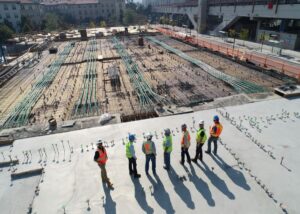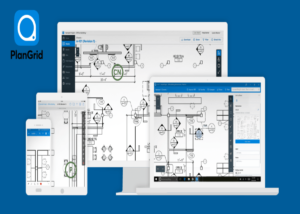The construction industry is evolving, and with it, the approach to project management must adapt to meet new challenges and opportunities. This article provides a fresh perspective on construction project management, exploring how redefining safety performance, leveraging advancements in software, managing resources strategically, fostering collaboration and communication, and navigating the changing landscape can lead to more successful outcomes. By examining these key areas, project managers can gain insights into how to enhance efficiency, improve safety, and ensure project success in the modern construction environment.
Table of Contents
Key Takeaways
- Adopting a holistic view of safety performance by considering the diverse perspectives of all stakeholders can lead to more effective safety measures and a safer construction environment.
- Utilizing advanced project management software provides enhanced visibility and facilitates better resource allocation, contributing to more efficient and effective project execution.
- Strategic resource management, including the optimization of materials, labor, and technology, is crucial for achieving sustainability and cost-effectiveness in construction projects.
- Effective collaboration and communication, supported by digital tools, are fundamental to maintaining a cohesive team and ensuring all stakeholders are informed and engaged.
- Staying abreast of evolving regulations, embracing innovative construction techniques, and committing to continuous professional development are essential for navigating the future of construction project management.
Redefining Safety Performance in Construction Management with Viewpoint

Incorporating Multifaceted Stakeholder Perspectives
In the realm of construction project management, the concept of safety performance is evolving to include a broader range of stakeholder perspectives. Project managers are pivotal in fostering an autonomy-supportive environment that values the input of all stakeholders, including frontline safety officers. This inclusive approach is essential for cultivating a positive safety climate and reducing accident occurrence.
By engaging stakeholders throughout the project lifecycle, construction firms can ensure that the diverse definitions of project success and safety performance are aligned with the collective objectives.
Understanding the multifaceted views of clients, project managers, and safety officers is crucial. Each group has its own perception of what constitutes success and safety, which can vary significantly. To capture these varying perspectives, satisfaction levels, encompassing aspects of safety climate and accident rates, are considered as key indicators.
- First, assess the satisfaction levels of each stakeholder group.
- Second, integrate their feedback into safety training programs.
- Third, align safety objectives with the broader project goals.
In conclusion, the integration of diverse stakeholder perspectives into safety performance metrics is not just a strategic move but a necessary evolution in construction management. It ensures that the safety measures resonate with the real-world experiences and expectations of those on the ground.
Proactive Safety Measures and Performance Metrics
In the realm of construction project management, the emphasis on safety performance has shifted towards a more proactive approach. Proactive safety measures are not just about adhering to regulations; they are about creating a culture of safety that permeates every level of an organization. This cultural shift is often reflected in the safety climate—the collective attitude towards safety practices within the workforce.
By establishing a strong safety climate, companies can anticipate potential hazards and implement strategies to prevent accidents before they occur.
To quantify the effectiveness of these measures, performance metrics are essential. They provide a tangible way to assess the impact of safety initiatives and guide continuous improvement. Below is an example of how safety performance can be structured:
- Safety Climate Assessment
- Employee Perception Surveys
- Management Commitment Evaluations
- Accident Frequency Tracking
- Incident Reports
- Near-miss Analysis
These metrics not only help in measuring current safety standards but also in setting benchmarks for future safety objectives. It is crucial that these metrics are regularly reviewed and updated to reflect the dynamic nature of construction sites and the evolving best practices in safety management.
Aligning Safety Objectives with Project Success
The alignment of safety objectives with project success is not just a regulatory requirement but a strategic approach that enhances the overall project outcome. Safety officers play a pivotal role in this alignment, acting as the nexus between various stakeholders and the implementation of comprehensive safety programs. Their unique position allows them to influence the quality of safety measures, which is integral to the success of construction projects.
Stakeholder perspectives on safety performance vary significantly, with each party prioritizing different aspects. For instance, contractors may focus on maintaining a clean safety record for reputational purposes, while project owners might emphasize a comprehensive approach to minimize all potential risks. It is crucial to evaluate and synthesize these perspectives to achieve a holistic understanding of the safety climate within a project.
By fostering a culture of safety that aligns with the project’s success metrics, organizations can ensure that safety programs are not just compliant, but also contribute to the efficiency and effectiveness of the construction process.
To illustrate the importance of aligning safety objectives with project success, consider the following points:
- Safety programs should empower workers, promoting a proactive safety culture.
- A clear understanding of stakeholder perspectives is essential for effective safety performance evaluation.
- Safety officers must bridge the gap between project managers, clients, and workers to ensure cohesive safety strategies.
Ultimately, the goal is to integrate safety as a core component of project management, ensuring that it contributes positively to project timelines, budgets, and quality standards.
Advancements in Construction Project Management Software

Evaluating Software for Enhanced Project Visibility
In the realm of construction project management, enhanced visibility is not just a convenience—it’s a necessity. Selecting the right software is pivotal in achieving a comprehensive overview of project timelines and status. This level of insight empowers stakeholders to make informed, proactive decisions, ensuring projects remain on track.
When evaluating software options, it’s essential to consider how the tool will integrate with your organization’s existing workflows and delivery methodologies. The goal is to find a solution that not only provides enhanced visibility but also complements your team’s processes.
The key to successful software implementation is alignment with organizational practices and the specific outcomes desired from the technology.
Here are some benefits of prioritizing project visibility in software selection:
- Comprehensive project overview for timely adjustments
- Improved resource allocation and utilization
- Facilitated stakeholder communication and collaboration
It’s important to compare software features methodically, focusing on the tangible benefits they offer. Our extensive research and reviews of over 2,000 tools can guide you in making an informed choice that aligns with your project management needs.
Integrating Resource Allocation and Efficiency
The integration of resource allocation and efficiency within construction project management software is pivotal for the streamlined execution of projects. Optimal use of materials, labor, and equipment is ensured by precise tracking and scheduling, which not only reduces waste but also enhances profitability.
Key features of such software include:
- Task Scheduling and Assignment
- Budgeting and Cost Control
- GPS Tracking for Resource Allocation
- Customizable Reports and Dashboards
By leveraging these tools, project managers can maintain the project within budget and prevent overruns, while ensuring that resources are effectively utilized.
The adoption of these systems facilitates a more cohesive and responsive approach to managing construction projects, with a focus on achieving peak efficiency. It is essential for project managers to select software that aligns with their specific workflow and methodology to fully capitalize on these benefits.
Selecting Tools for Improved Workflow and Methodology Compatibility
The selection of project management tools is pivotal in enhancing workflow and ensuring compatibility with established methodologies. Choosing the right software requires a careful assessment of features and functionalities that align with the specific needs of a construction project. Tools such as BuilderTREND have set a benchmark in the industry by offering comprehensive solutions for resource allocation, scheduling, and mobile access, which are essential for modern construction management.
When evaluating tools, consider the following aspects:
- Usability and user-friendly interface design
- Robust security features
- Compatibility with existing workflows and processes
- Support for collaboration and team management
Evaluate what’s working well, and the areas that are causing issues that need to be addressed. Remember every business is different — don’t assume that because a tool is popular that it’ll work in your organization.
Ultimately, the goal is to select a tool that not only improves workflow but also contributes to the overall success of the project. This requires a balance between innovative features and the practicality of integrating them into the current project management ecosystem.
Strategic Resource Management in Modern Construction

Optimizing Material and Labor Utilization
In the realm of construction project management, optimizing material and labor utilization is pivotal for enhancing efficiency and reducing unnecessary expenditures. Precise tracking and scheduling of resources, facilitated by advanced management software, are essential for minimizing waste and maximizing the use of materials and labor. This not only leads to cost savings but also boosts overall profitability.
Resource allocation plays a critical role in ensuring that every aspect of the construction process is executed with the utmost precision. By employing construction quality management protocols, such as regular testing and inspections, the quality of workmanship is upheld, preventing costly errors and the need for rework.
Effective resource management is not just about cutting costs; it’s about achieving a balance between resource availability and project demands, ensuring that every element aligns with the project’s timeline and quality standards.
Here are key steps to optimize resource utilization:
- Conduct thorough materials testing and inspections to guarantee quality.
- Implement regular monitoring to ensure workmanship meets required standards.
- Utilize construction project management software for real-time insights into resource availability.
- Adjust project schedules proactively to align with resource allocation.
Leveraging Technology for Equipment Management
The integration of technology into equipment management has revolutionized the way construction companies oversee their assets. By leveraging technology, construction firms gain the ability to monitor and manage their heavy machinery with unprecedented precision. This not only enhances operational efficiency but also contributes to better maintenance scheduling and reduced downtime.
Integration with GPS and Mobile Capabilities has become a cornerstone in modern equipment management. Tools like Contractor Foreman offer real-time tracking of machinery, which is crucial for optimizing the use of resources and ensuring timely project completion. The benefits of such technology extend beyond mere location tracking, encompassing improved dispatch efficiency and project scheduling.
Embracing technology in equipment management allows for a more dynamic and responsive approach to construction project challenges.
To fully appreciate the impact of technology on equipment management, consider the following aspects:
- Efficient task and phase tracking
- Centralized document management for easy access to plans, permits, and contracts
- Enhanced communication channels for seamless interaction among stakeholders
- Contractor and subcontractor management to streamline collaborations
Sustainability and Cost-Effectiveness in Resource Allocation
In the realm of construction project management, the emphasis on sustainability is not just an environmental concern but also a strategic approach to achieving long-term cost predictability and resilience. Sustainable practices in resource allocation can lead to significant cost savings and increased profitability by optimizing the use of materials, labor, and equipment.
Efficient resource management software plays a pivotal role in this process, offering features such as precise tracking and scheduling, which are essential for reducing waste and enhancing cost-effectiveness. The table below outlines key software features that contribute to sustainable resource allocation:
| Feature | Description |
|---|---|
| Improved Resource Allocation | Optimal use of resources, reducing waste |
| Streamlined Communication | Centralized channels, up-to-date information |
| Task Scheduling and Assignment | Right resources for tasks, avoiding delays |
| Budgeting and Cost Control | Monitoring expenses, accurate cost forecasting |
By integrating these software capabilities, project managers can ensure that every aspect of resource management is aligned with both sustainability goals and the project’s financial objectives. This alignment is crucial for the long-term success and viability of construction projects.
Creating a realistic budget that encompasses all direct and indirect costs is another fundamental step towards sustainable resource allocation. It is imperative to monitor and control costs throughout the project’s lifecycle to maintain financial discipline and avoid budget overruns.
Collaboration and Communication: The Pillars of Project Management

Streamlining Team Interaction with Digital Tools
In the realm of construction project management, the adoption of digital tools has been a game-changer for team interaction. Facilitating regular team meetings through digital platforms ensures that all members are aligned with the project’s progress and objectives. These meetings are crucial for addressing challenges and fostering a collaborative environment.
Leveraging collaboration tools is essential for real-time interaction among team members. Platforms such as Slack, Microsoft Teams, and Google Workspace not only enable document sharing and virtual whiteboarding but also allow for simultaneous editing, significantly enhancing team productivity.
The integration of communication tools into daily operations is pivotal for maintaining quality standards in construction. Improved Collaboration ensures that any issues related to quality control are addressed promptly, reducing potential delays.
The following list highlights key digital tools that streamline team interaction:
- Communication and collaboration platforms (e.g., Slack, Microsoft Teams)
- Document management systems (e.g., Dropbox, Google Drive)
- Project management applications with intuitive interfaces and mobile compatibility
- Integration with other software for seamless data flow and accessibility
Real-Time Updates and Document Management
The cornerstone of effective construction project management lies in the ability to provide stakeholders with access to the most up-to-date project information. Real-time project tracking is not just a convenience; it’s a critical component for maintaining project momentum and avoiding costly delays. Immediate insight into project status allows for the early identification of bottlenecks, ensuring that projects remain on schedule.
Centralized document management is another key aspect that cannot be overstated. By consolidating all project-related documents—RFIs, change orders, contracts, blueprints, and more—into a single repository, stakeholders can be confident that they are working from the latest information. This level of organization is essential for minimizing the risk of miscommunication and errors, which in turn improves collaboration and project outcomes.
The integration of document management systems and digital tools streamlines the workflow, making it easier to manage, store, and track critical documents. With features like automated documentation and compliance, project managers can simplify adherence to regulations and enhance overall efficiency.
When selecting tools for document management, consider the following:
- Document Workflow Software
- Digital Asset Management Software (DAM)
- Project Dashboards
- Governance Risk & Compliance Tools (GRC)
- File Sharing Software
- Client Database Software
Enhancing Stakeholder Engagement through Transparency
Transparency in construction project management is not just a buzzword; it’s a strategic approach that can significantly enhance stakeholder engagement. Open lines of communication enable project managers to address concerns, manage expectations, and build consensus. By setting clear communication expectations and encouraging an environment of open and transparent communication, stakeholders feel more involved and valued.
Stakeholder engagement is a critical component that influences not only the satisfaction but also the safety performance of a project. Automated tools and software play a pivotal role in this aspect by providing real-time updates and ensuring that all parties have access to the latest information, documents, and schedules. This reduces the risk of miscommunication and errors, thereby improving collaboration and project outcomes.
By implementing effective communication and collaboration strategies, project managers can foster a culture of transparency, teamwork, and trust, leading to improved project outcomes and stakeholder satisfaction.
Navigating the Evolving Landscape of Construction Project Management

Adapting to New Safety Regulations and Standards
The construction industry is continually evolving, and with it, the safety regulations and standards that govern project management. Adapting to these changes is not just a legal obligation but a moral imperative to ensure the well-being of all stakeholders involved.
Compliance with new safety regulations often requires a multifaceted approach, including the evaluation of safety programs, enhancement of personal competence, and the acquisition and maintenance of safety equipment. Effective supervision, coupled with safety education and training, forms the backbone of a robust safety management system.
The integration of these elements into the daily operations of construction management is crucial for the establishment of an exemplary safety culture.
To illustrate the complexity of safety management in construction, consider the following factors that must be harmoniously integrated:
- Programme evaluation and continuous improvement
- Enforcement schemes and personal accountability
- Safety equipment acquisition, maintenance, and innovation
- Effective supervision and leadership in safety practices
- Comprehensive safety education and training
- Safety promotion policies that encourage a culture of safety
- Safety knowledge dissemination and best practices sharing
Each of these components plays a vital role in not only meeting but exceeding the standards set forth by regulatory bodies. As the landscape of construction project management continues to shift, staying informed and agile in the face of new safety regulations will be key to maintaining a competitive edge and safeguarding the health and safety of all.
Embracing Innovative Construction Techniques
The construction industry is witnessing a paradigm shift with the introduction of groundbreaking techniques that promise to revolutionize project execution. Innovative construction techniques are not just about adopting new tools, but also about rethinking the entire construction process to enhance efficiency and outcomes.
3D Modeling Integration is one such innovation that has been gaining traction. By allowing project managers to visualize conflicts and plan more effectively, this technology is setting a new standard in construction planning and execution.
Embracing these innovations requires a mindset that values continuous improvement and is open to change. It is essential for construction professionals to stay informed about the latest advancements and to integrate them into their practices.
The following list highlights some of the key innovations that are shaping the future of the construction industry:
- Advanced materials that offer better durability and sustainability
- Prefabrication and modular construction for faster and more cost-effective builds
- Automated and robotic systems to improve precision and reduce labor costs
As we move forward, it is crucial to recognize that these innovations are not just optional extras but are becoming integral to staying competitive in a rapidly evolving industry.
Staying Ahead with Continuous Professional Development
In the dynamic field of construction project management, continuous professional development (CPD) is not just a formality; it’s a necessity for staying relevant and effective. CPD ensures that project managers are not only up-to-date with the latest industry trends and technologies but also equipped with the skills to handle complex projects efficiently.
To maintain a competitive edge, project managers should focus on areas such as Personal Growth, Personal Productivity Hacks, and staying informed about All Personal Topics related to the industry. This holistic approach to professional development can lead to significant improvements in project outcomes.
By embracing CPD, project managers can anticipate future challenges and adapt their strategies accordingly, ensuring long-term project success.
Furthermore, engaging in various forms of CPD, including Training, Certificate Programs, Mini Courses, and Project Management Training For Agencies, can provide a structured path for career advancement. It’s crucial to select the right mix of learning opportunities that align with career goals and project requirements.
Here’s a quick guide to areas of focus for CPD:
- Managing Schedules
- Managing Quality
- Managing Procurements
- Conflict Resolution
These areas are essential for project managers to master, as they directly contribute to the efficiency and success of construction projects.
Conclusion
In summary, the evolving landscape of construction project management demands a new perspective that embraces the viewpoints of all stakeholders, prioritizes safety, and leverages cutting-edge software tools. The insights gathered from safety officers, clients, and project managers underscore the multifaceted nature of safety performance and project success. As we look towards the trends of 2024, it is clear that enhanced project visibility, improved resource allocation, and proactive behavior-based safety management will be at the forefront of industry advancements. By adopting a comprehensive approach to software selection and integrating it seamlessly into organizational workflows, construction project management can achieve greater efficiency, reduce errors, and ensure projects are delivered on time and within budget. This article has aimed to provide a foundation for understanding these complex dynamics and to encourage informed decision-making for those seeking to excel in the construction industry.
Frequently Asked Questions
How does incorporating multifaceted stakeholder perspectives improve safety performance in construction management?
Incorporating multifaceted stakeholder perspectives, including those of clients, project managers, and safety officers, leads to a more comprehensive understanding of safety performance. This approach ensures that safety measures are aligned with the diverse expectations and objectives of all involved parties, fostering a safer and more engaged work environment.
What are the key benefits of advancements in construction project management software?
Advancements in construction project management software provide enhanced project visibility, improved resource allocation, and better workflow compatibility. These features facilitate proactive decision-making, efficient use of materials and labor, and seamless integration with company processes, ultimately leading to more successful project outcomes.
How can modern construction software contribute to strategic resource management?
Modern construction software aids in optimizing material and labor utilization, managing equipment effectively, and ensuring sustainability and cost-effectiveness in resource allocation. This technology streamlines operations, reduces waste, and supports informed decision-making for better project management.
What role do collaboration and communication play in construction project management?
Collaboration and communication are fundamental to successful construction project management. Digital tools that streamline team interactions, provide real-time updates, and manage documents help enhance transparency, improve stakeholder engagement, and ensure that all team members are aligned and informed throughout the project lifecycle.
How can construction managers adapt to the evolving landscape of construction project management?
Construction managers can adapt by staying informed about new safety regulations and standards, embracing innovative construction techniques, and engaging in continuous professional development. This proactive approach enables them to navigate changes effectively and maintain a competitive edge in the industry.
What are the current trends in construction project management software for 2024?
Trends for 2024 include a focus on software that provides greater visibility into project performance, compatibility with existing workflows and delivery methodologies, and features that drive desired outcomes. Emphasis is also on usability, innovative features, and customer support to add value beyond fundamental project tracking and management.






Pingback: The Role of AI in Civil Engineering: A New Era in Design, Management, and Analysis